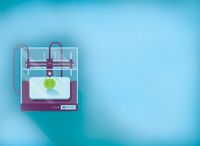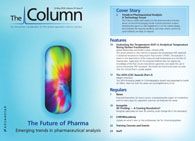3D Printing — A Coming Revolution?
Incognito speculates on how 3D printing could change life in the laboratory.
Incognito speculates on how 3D printing could change life in the laboratory.
I hate being in that intellectual hinterland where I am on the fringe of conversations without knowing enough to contribute in any meaningful way. As a relatively "early adopter" on the technology curve, I always liked to keep up-to-date with the latest advances, without straying into "geekdom" too far! On a recent trip to the Science Museum in London, UK, I felt very much in the hinterland as I toured an excellent exhibition on 3D printing. Working printers, the varied products of these printers, and some very stimulating pieces on what 3D printing may mean for us in the future were all on display.

Photo Credit: akindo/Getty Images
In an attempt to get ahead of the curve, I've read up a little and spoken to a few very early adopters of the technology about their experiences. This includes my own son: His school's technology department has had one for absolutely ages and in his words "Oh my goodness Dad, where on earth have you been!" The basics of 3D printing using the "additive manufacturing" approach are reasonably straightforward. In fused deposition modelling (FDM), a thermoplastic filament (wire) of poly lactic acid (PLA) or acrylonitrile butadiene styrene (ABS) is fed into a heated print head that extrudes the molten plastic and deposits layers or dots, according to a 3D printable stereolithography (STL) file, which builds up the object in layers from the fast thermosetting plastic. Once completed, the piece has any sprues (frames) removed and is filed smooth and finished or is finished by a higher resolution printing device using a subtractive (ablation or similar) process. The resolution of the printer and the number of different print heads and feedstock materials it can handle are linked to cost. Lower resolution printers are available for under $500 while high-resolution, large format printers using multiple feedstocks can cost hundreds of thousands of dollars. Other printing processes such as granular materials binding (GMB) and print feedstock materials are available, and all of the variations can of course be studied in more detail from the excellent Wikipedia article.1
The applications of the technology rather than the technology itself are the most fascinating. On display at the exhibition at the Science Museum were running shoes, models of organs, foetuses, and brains, prosthetics, "selfies" of loved ones and pets, and a working hand-cranked version of a ¼-scale rotary aeroplane engine — all printed in a single session with no further assembly required. More serious and beneficial applications are seen in bio-printing where living cells are deposited onto a gel medium to build up 3D structures that can include intricate vascular systems that have already been used to research the potential manufacture of trachea, major blood vessels, and liver and kidney tissue. Prosthetic applications have included pelvic reconstructions from titanium, jaw bones, facial implants, and long bones and joints. A nice summary on what's hot in 3D printing (no pun intended) can be found in a recent article in The Guardian.2
Given the nature of this column, we should really think about where the technology might fit into the analytical laboratory, but I do feel that a discussion on plastic egg flippers is needed first. I recently argued with a colleague when they suggested that soon every home will have a 3D printer as it would be really cool to simply print out a new egg flipper when your previous one breaks. No, clearly you would travel to your nearest kitchenware shop or go on-line and buy one — it's not that you absolutely have to have an egg flipper. You can use pretty much anything else for flipping eggs in a pan. My contention is that 3D printers will be used to produce items which are highly personal (prosthetics/orthotics/"selfies"), or when you absolutely need that item right now and can't get it from anywhere else without major inconvenience or a long wait.
Where does this leave the use of 3D printing in the laboratory then? I've thought of a few applications, but I'd love to hear more from our readers.
- Piston seals for high performance liquid chromatography (HPLC) pump heads — Your consumables cupboard is fresh out of them and you absolutely need to put that campaign of samples on overnight. By the way, for pump seal read (perhaps) pistons or check valves — although this would require us printing some pretty special plastics, which will resist wear and pH extremes and have certain mechanical properties.
- Printing metal alloys is possible using a number of techniques, including selective laser sintering (SLS), but I can't see this coming to a laboratory near me soon unless costs can be significantly reduced.What would you use to construct the ruby ball in the check valve?
Professor Lee Cronin at Glasgow University (Glasgow, UK) leads a group who are producing bespoke micro-reactor units, and using the technology to test out new flow through synthetic routes: A little out of our area perhaps but could the technology be used to print out new "chip" designs for HPLC or gas chromatography (GC) systems to which other simple components are added? Or perhaps new systems could be designed into which the printed chips are integrated?3 Perhaps capillary electrophoresis (CE) system cartridges could be designed and printed — again to "plug and play" into integrated systems. There is once again the issue of "printing" chemistry (stationary phases) onto the inside of these devices, which is not possible at the moment. That doesn't mean we could not come up with a way of functionalizing plastic or ceramic feedstock materials in the future. Perhaps plastic support materials for chromatography may have their day after all?
My feeling is that early applications of 3D printing will result in similar benefits to that offered by ultrahigh-pressure liquid chromatography (UHPLC) or FAST GC, in that one can significantly speed up development tasks. I'm now developing chromatography methods overnight (previously impossible) thanks to the speed of my chromatography equipment and columns. Perhaps 3D printing will make it possible for us to adapt or develop new instrumentation in the same way and I can develop and print a fully integrated HPLC system which has dead volume low enough to really take advantage of small internal diameter HPLC columns packed with sub 1-μm particles — but I guess that's another installment altogether!
If you haven't yet had the opportunity to contemplate how 3D printing will affect your lives, both personal and working, I would urge you to do so now. The revolution is coming, and there will be no stopping it.
References
1. 3D Printing, Wikipedia: bit.ly/19C48fJ
2. 30 things being 3D printed right now (and none of them are guns), The Guardian: bit.ly/L8AR2p
3.P.J. Kitson, M.H. Rosnes, V. Sans, V. Dragone, and L. Cronin, Lab Chip 12, 3267–3271 (2012).
Contact author: Incognito
E-mail: incognito@thecolumn.eu.com
This article is from The Column. The full issue can be found here:http://images2.advanstar.com/PixelMags/lctc/digitaledition/May22-2014-uk.html#10

Evaluating the Accuracy of Mass Spectrometry Spectral Databases
May 12th 2025Mass spectrometry (MS) can be effective in identifying unknown compounds, though this can be complicated if spectra is outside of known databases. Researchers aimed to test MS databases using electron–ionization (EI)–MS.

.png&w=3840&q=75)

.png&w=3840&q=75)



.png&w=3840&q=75)



.png&w=3840&q=75)










